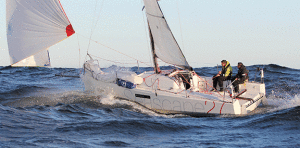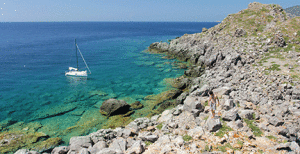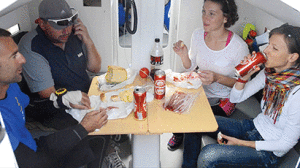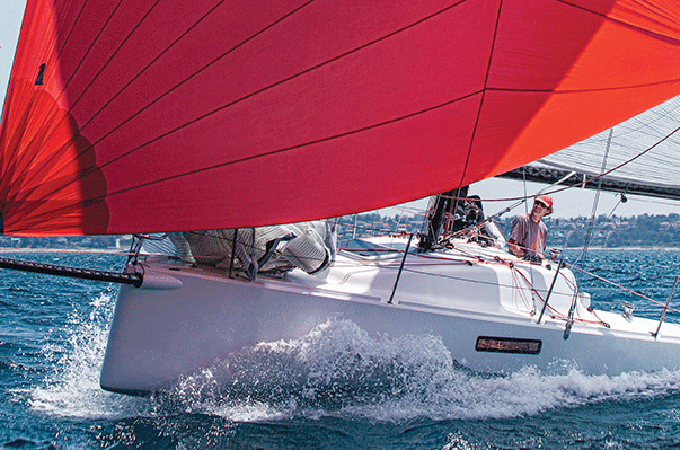An inventive, offshore capable racer-cruiser that provides quite a thrill, by Andrew Cross
I knew I was in for a ride when I left my hotel and drove to Bert Jabin’s Yacht Yard on Back Creek in Annapolis, Maryland in October to sail the Seascape 27. The tops of autumn-colored trees were being whipped into a frenzy and I had the windshield wipers going at half speed. The weather radar on my iPad showed showers moving through the area at a brisk pace, with more wind to follow.
Sure enough, as soon as my hosts Jon and Svein and I cleared the channel out of Back Creek, a dark squall was fast approaching. I pulled my hood over my head, shifted in my seat to put my back to the wind and rain, and gripped the tiller. A heavy downpour ensued followed by a rush of wind. The tempest soon passed and what we were left with for our morning sail was a fresh breeze between 15 and 25 knots with higher gusts—perfect conditions for testing the Seascape 27, a boat that by all accounts was capable of making blue water voyages or winning blue ribbons on the racecourse.
UNDER SAIL
 With the Spinlock tiller extension in one hand and the mainsheet in the other, I brought the boat into the building breeze and Jon got the surprisingly large yet manageable square-topped main up and set. With the main drawing, I fell off the wind and eased the sheet while Svein turned off and stowed the 6hp outboard engine that was ingeniously fitted into a compartment in the cockpit sole.
With the Spinlock tiller extension in one hand and the mainsheet in the other, I brought the boat into the building breeze and Jon got the surprisingly large yet manageable square-topped main up and set. With the main drawing, I fell off the wind and eased the sheet while Svein turned off and stowed the 6hp outboard engine that was ingeniously fitted into a compartment in the cockpit sole.
This is something you have to see to believe, because I had truly never witnessed anything like it before stopping by the boat to get a tour at the Annapolis boat show. With no engine hanging from the stern, I wondered if the 27 had a small diesel inboard. But Svein invited me aboard from dockside and pulled open a hatch in the cockpit sole to reveal an outboard lying on its side. He then stepped down into the well, opened another hatch in the bottom of the boat and effortlessly articulated the engine up, back and then down into the water. Genius. Passers-by took notice, slowed to a stop and one dazzled show-goer asked for the demo again.
Making way now under main alone, we worked eastward towards the bay and Jon put up the genoa. With full canvas set and the breeze piping up, we got out of the lee of nearby Tolly Point and the waves began to build. Healing sharply, but locked in on the boat’s hard chine, we aggressively punched through the steep chop rolling in from the southeast and I was surprised that the 27 was able to keep up a good head of steam—marching along at just under 6 knots. Rather than constantly easing and trimming the mainsheet in the gusts, I played the traveler with my non-steering hand and the response on the helm was noticeable.
Though the helm stayed light and the boat easy to steer, we were getting frequent gusts in the mid to upper 20s, so we decided that putting in a reef was the prudent decision. I fell off the wind just slightly and eased the main so Jon could work the control lines and he quickly got the reef in from the forward end of the cockpit using the Andersen winches on either side of the cabin top.
 With the reef tucked in, we put the boat through a few tacks and I steered quickly through head to wind in order to avoid taking any of the steep seas square on the bow. Upwind the boat did exceptionally well, especially given the snotty conditions. We sailed at 30 degrees apparent and I enjoyed the clean, well laid out cockpit as I moved from side to side, passing the tiller easily behind my back before taking a seat. I’m sure in a lighter breeze with full sail, the boat could point slightly higher. Also, I was glad to have the dual outboard rudders, as the steering never faltered, even as we got laid over in the stronger gusts.
With the reef tucked in, we put the boat through a few tacks and I steered quickly through head to wind in order to avoid taking any of the steep seas square on the bow. Upwind the boat did exceptionally well, especially given the snotty conditions. We sailed at 30 degrees apparent and I enjoyed the clean, well laid out cockpit as I moved from side to side, passing the tiller easily behind my back before taking a seat. I’m sure in a lighter breeze with full sail, the boat could point slightly higher. Also, I was glad to have the dual outboard rudders, as the steering never faltered, even as we got laid over in the stronger gusts.
The moment that we had all been waiting for finally arrived when we made it far enough out into the bay to turn back for some good, fast, downwind sailing. Down came the genoa, out came a bigger reaching sail and up went the main. As I footed off the wind the Seascape 27 absolutely took off like a rocket. Surfing down waves, we all hooted and hollered while watching the boat speed climb to 10, 11, 12 and 13 knots before topping out at 14. If we’d had a large A-sail up and flying from the adjustable sprit pole, I bet we could have hit 18. Looking back at our wake, it seemed as though we were skipping across the water as we planed. And we may have been.
Having sailed many keelboats in this size range and in this amount of breeze, I was waiting for the moment at the helm when I felt out of control—like we were going to lose it and broach. But it never happened. The boat was solid and safe and clearly designed to be handled in the breeze and seas we had with the amount of canvas we were flying. Jon even said an autopilot could be fitted and would handle the conditions. I didn’t doubt it.
Jibing was another matter that I wondered about with the amount of breeze and sail area we were in, but again, the 27 handled it with poise. I sheeted the main in before each jibe as I slowly turned the stern through the wind and then eased it back out quickly as the sails filled and the boat shot itself out of a cannon. This was some seriously fun sailing.
THE DESIGN
The Seascape brand is the brainchild of experienced Mini Transat sailors Kristian Hajnšek and Andraž Mihelin who tabbed Sam Manuard to do the design. They started with the Seascape 18 in 2008 and after finding success with it, decided to design and build a larger boat that would be able to excel in a wider variety of conditions. What they came up with was the Seascape 27, which debuted in 2012 and has come on strong over the last few years in Europe and is just gaining traction in the U.S. Built in Slovenia, the boats have a uniqueness to them that is original and fresh in this size range.
Mini sailors are a unique bunch that love sailing across oceans, are passionate about seamanship and have an adventurous spirit. What they’re not necessarily known for is a zeal for cruising, but the Seascape 27 was designed with an eye towards enjoying offshore racing or cruising to your favorite weekend anchorages.
This duality of design is apparent throughout the boat and actually works quite well. For instance, on the performance side she was given a carbon fiber rig with generous sail plan. The high aspect mainsail, retractable sprit pole for headsails, dual rudders and hard chines makes for a fast boat on all points of sail. And given that her keel down draft is six foot three inches with 1,200 lbs of ballast, it’s no wonder she was so stable when the wind was whistling on the Chesapeake.
Cruising wise, the 27 has a retractable keel and rudders that can get you into waist deep water, a proper anchor locker forward, and the ability to sail in everything from a light breeze to a gale thanks to a sail plan that can go from a full main and genoa or A-sail on the sprit to a deeply reefed main and a small jib on an inner forestay. I would also consider this rig setup to be a safety feature, and being that the boat is the creation of experienced offshore sailors, safety was a key element to the design and build.
They strictly followed the CE Category B (Offshore) and ISAF OSR Category 3 safety rules and it shows, as the boat is exceptionally seaworthy. GRP vacuum-infusion construction gives the 27 a powerful and stiff hull form and buoyancy chambers fitted into the bow and to port and starboard under the cockpit will keep the boat afloat in the event of a hull breach. Also, there is a storage area for a life raft built into the stern, which takes care of that space issue while also putting it in a place that is easy to deploy in the event of an emergency.
Another aspect of the 27 that aligns with cruising and racing functionality alike is that the boat is easy to transport. With a beam of eight feet four inches, it conforms to highway standards for trailering and at a total weight of just over 2,500 lbs, can be towed by a modest SUV. It can also fit inside a 40-foot shipping container on its trailer, so an owner could literally pull the boat to a shipyard, put it in a box and ship it to any cruising or racing destination in the world. That is an appealing amount of flexibility for any boat.
THE INTERIOR
When most sailors think of a 27-foot boat, they’re not envisioning well-conceived comfort down below. Despite its relatively narrow beam, though, when you drop into the 27’s cabin, the interior is reasonably spacious. It was raining when I stopped by to see the Seascape at the show, and four of us sat down below to chat about the boat without being cramped or uncomfortable.
 Forward there is a V-berth cabin that doubles as a wet room and sail locker. Just aft is a marine head with an inventive system of folding doors that turns the space from a head to a wet locker to a storage space. In the main cabin and living space there are two bench seats that can be used as berths, with two more berths aft under the cockpit. Outboard of the benches are storage areas with integrated hanging bags that can be taken off, filled at home and then brought back to the boat and hung up. A gimbaled cooking stove comes in its own bag and can be mounted or un-mounted easily for use or storage.
Forward there is a V-berth cabin that doubles as a wet room and sail locker. Just aft is a marine head with an inventive system of folding doors that turns the space from a head to a wet locker to a storage space. In the main cabin and living space there are two bench seats that can be used as berths, with two more berths aft under the cockpit. Outboard of the benches are storage areas with integrated hanging bags that can be taken off, filled at home and then brought back to the boat and hung up. A gimbaled cooking stove comes in its own bag and can be mounted or un-mounted easily for use or storage.
Two companionway steps fold up to reveal storage and an icebox, and I’m told a small refrigeration unit can be installed. A modest amount of house electronics is located on a panel just under the companionway and an articulating multifunction display can swing horizontally in and out for use underway.
One of the cleverest features down below is the center table that can be transformed into a nav station and desk. The top of the keel-box can house a folding leaf table or a waterproof case that contains a laptop and navigation tools. A folding motorcycle-esq seat can also attach to the keel-box so the navigator has a comfortable place to sit.
Colors of cushions and storage bags are an option and a certain level of customization can be achieved within the cabin setup.
BWS THOUGHTS
I was probably smiling during the entire drive back to my hotel from the marina. My premonition of an exhilarating sail had come true and I have to admit, this test was the most fun I’d had on a sailboat in a long time. And having seen videos of the Seascape 27 since its launch, I was glad to be able to finally see and sail the boat.
Some may scoff at the notion that this 27-foot boat would be offshore capable, fun to race and also able to do some modest cruising. But after giving it a good heavy weather test on the Chesapeake Bay, I’d feel comfortable doing just about anything with it and came away with the impression that the designers have done a lot of things right with this boat.
For a modern sailing landscape that is seeing some boat owners move down in size and an increasing number of small families and young professionals getting into the sport, this boat and its many purposes can be right for a lot of people. Sure, you may not live aboard it or take off for years of cruising, but it is a great option for those looking to have a moderate sized boat that they can keep rigged on a trailer or waiting in a slip for however and whenever they want to use it.
And when you’re done sailing it in your home waters, why not just ship it to those exotic places that you’ve always dreamed of cruising to?
Seascape 27
LOA 26’3”
Beam 8’4”
Draft 6’3” or 3’2”
Sail Area 495 sq. ft.
Displacement 2,535 lbs
www.thinkseascape.com

















